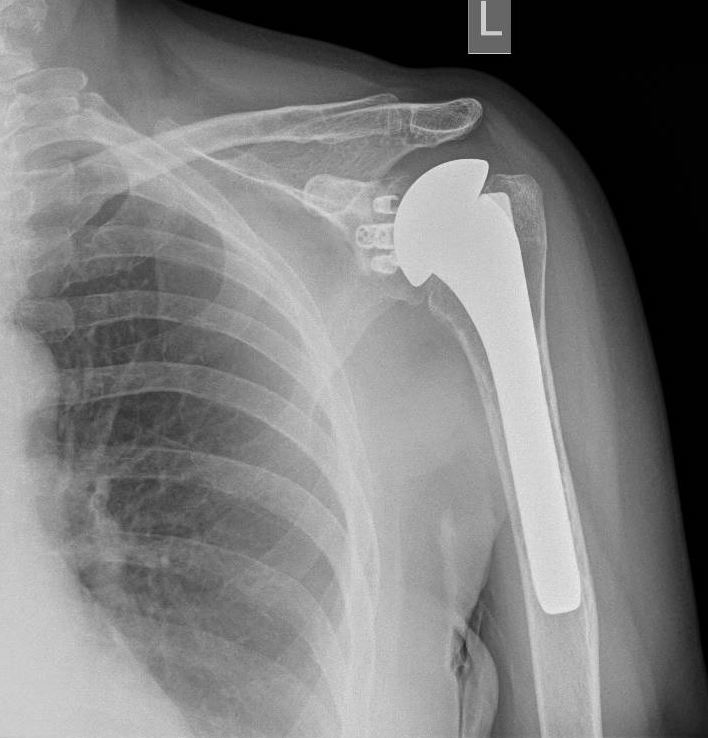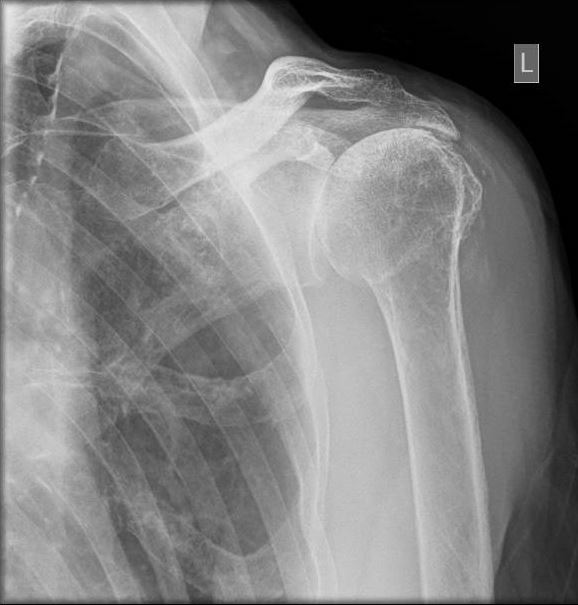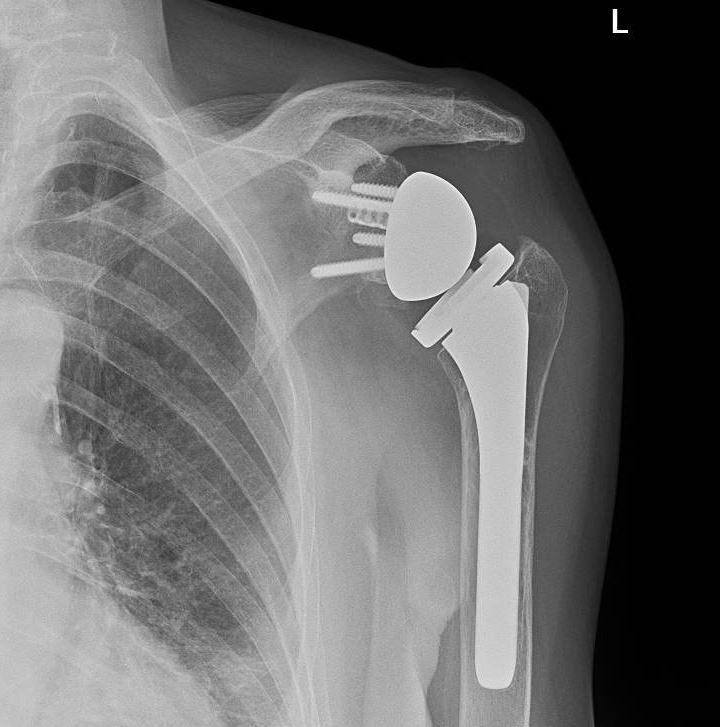[1]
Best MJ, Aziz KT, Wilckens JH, McFarland EG, Srikumaran U. Increasing incidence of primary reverse and anatomic total shoulder arthroplasty in the United States. Journal of shoulder and elbow surgery. 2021 May:30(5):1159-1166. doi: 10.1016/j.jse.2020.08.010. Epub 2020 Aug 26
[PubMed PMID: 32858194]
[2]
Reeves B, Jobbins B, Flowers F, Dowson D, Wright V. Some problems in the development of a total shoulder endo-prosthesis. Annals of the rheumatic diseases. 1972 Sep:31(5):425-6
[PubMed PMID: 5071643]
[3]
Baulot E, Sirveaux F, Boileau P. Grammont's idea: The story of Paul Grammont's functional surgery concept and the development of the reverse principle. Clinical orthopaedics and related research. 2011 Sep:469(9):2425-31. doi: 10.1007/s11999-010-1757-y. Epub
[PubMed PMID: 21210311]
[4]
Cheung E, Willis M, Walker M, Clark R, Frankle MA. Complications in reverse total shoulder arthroplasty. The Journal of the American Academy of Orthopaedic Surgeons. 2011 Jul:19(7):439-49
[PubMed PMID: 21724923]
[5]
Flatow EL, Harrison AK. A history of reverse total shoulder arthroplasty. Clinical orthopaedics and related research. 2011 Sep:469(9):2432-9. doi: 10.1007/s11999-010-1733-6. Epub
[PubMed PMID: 21213090]
[6]
Chang LR, Anand P, Varacallo M. Anatomy, Shoulder and Upper Limb, Glenohumeral Joint. StatPearls. 2024 Jan:():
[PubMed PMID: 30725703]
[7]
Lugo R, Kung P, Ma CB. Shoulder biomechanics. European journal of radiology. 2008 Oct:68(1):16-24. doi: 10.1016/j.ejrad.2008.02.051. Epub 2008 Jun 3
[PubMed PMID: 18511227]
[8]
Jeong J, Bryan J, Iannotti JP. Effect of a variable prosthetic neck-shaft angle and the surgical technique on replication of normal humeral anatomy. The Journal of bone and joint surgery. American volume. 2009 Aug:91(8):1932-41. doi: 10.2106/JBJS.H.00729. Epub
[PubMed PMID: 19651952]
[9]
Grammont PM, Baulot E. The classic: Delta shoulder prosthesis for rotator cuff rupture. 1993. Clinical orthopaedics and related research. 2011 Sep:469(9):2424. doi: 10.1007/s11999-011-1960-5. Epub
[PubMed PMID: 21732025]
[10]
Boileau P, Watkinson DJ, Hatzidakis AM, Balg F. Grammont reverse prosthesis: design, rationale, and biomechanics. Journal of shoulder and elbow surgery. 2005 Jan-Feb:14(1 Suppl S):147S-161S
[PubMed PMID: 15726075]
[11]
Drake GN, O'Connor DP, Edwards TB. Indications for reverse total shoulder arthroplasty in rotator cuff disease. Clinical orthopaedics and related research. 2010 Jun:468(6):1526-33. doi: 10.1007/s11999-009-1188-9. Epub
[PubMed PMID: 20049573]
[12]
Boileau P, Sinnerton RJ, Chuinard C, Walch G. Arthroplasty of the shoulder. The Journal of bone and joint surgery. British volume. 2006 May:88(5):562-75
[PubMed PMID: 16645099]
[13]
Neer CS 2nd, Craig EV, Fukuda H. Cuff-tear arthropathy. The Journal of bone and joint surgery. American volume. 1983 Dec:65(9):1232-44
[PubMed PMID: 6654936]
[14]
Petrillo S, Longo UG, Papalia R, Denaro V. Reverse shoulder arthroplasty for massive irreparable rotator cuff tears and cuff tear arthropathy: a systematic review. Musculoskeletal surgery. 2017 Aug:101(2):105-112. doi: 10.1007/s12306-017-0474-z. Epub 2017 Apr 25
[PubMed PMID: 28444541]
Level 1 (high-level) evidence
[15]
Bufquin T, Hersan A, Hubert L, Massin P. Reverse shoulder arthroplasty for the treatment of three- and four-part fractures of the proximal humerus in the elderly: a prospective review of 43 cases with a short-term follow-up. The Journal of bone and joint surgery. British volume. 2007 Apr:89(4):516-20
[PubMed PMID: 17463122]
Level 3 (low-level) evidence
[16]
Wall B, Nové-Josserand L, O'Connor DP, Edwards TB, Walch G. Reverse total shoulder arthroplasty: a review of results according to etiology. The Journal of bone and joint surgery. American volume. 2007 Jul:89(7):1476-85
[PubMed PMID: 17606786]
[17]
Walker M, Willis MP, Brooks JP, Pupello D, Mulieri PJ, Frankle MA. The use of the reverse shoulder arthroplasty for treatment of failed total shoulder arthroplasty. Journal of shoulder and elbow surgery. 2012 Apr:21(4):514-22. doi: 10.1016/j.jse.2011.03.006. Epub 2011 Jun 8
[PubMed PMID: 21641825]
[18]
Levy J, Frankle M, Mighell M, Pupello D. The use of the reverse shoulder prosthesis for the treatment of failed hemiarthroplasty for proximal humeral fracture. The Journal of bone and joint surgery. American volume. 2007 Feb:89(2):292-300
[PubMed PMID: 17272443]
[19]
Holcomb JO, Hebert DJ, Mighell MA, Dunning PE, Pupello DR, Pliner MD, Frankle MA. Reverse shoulder arthroplasty in patients with rheumatoid arthritis. Journal of shoulder and elbow surgery. 2010 Oct:19(7):1076-84. doi: 10.1016/j.jse.2009.11.049. Epub 2010 Apr 2
[PubMed PMID: 20363159]
[20]
Feeley BT, Gallo RA, Craig EV. Cuff tear arthropathy: current trends in diagnosis and surgical management. Journal of shoulder and elbow surgery. 2009 May-Jun:18(3):484-94. doi: 10.1016/j.jse.2008.11.003. Epub 2009 Feb 8
[PubMed PMID: 19208484]
[21]
Naveed MA, Kitson J, Bunker TD. The Delta III reverse shoulder replacement for cuff tear arthropathy: a single-centre study of 50 consecutive procedures. The Journal of bone and joint surgery. British volume. 2011 Jan:93(1):57-61. doi: 10.1302/0301-620X.93B1.24218. Epub
[PubMed PMID: 21196544]
[22]
Grammont PM, Baulot E. Delta shoulder prosthesis for rotator cuff rupture. Orthopedics. 1993 Jan:16(1):65-8
[PubMed PMID: 8421661]
[23]
Grassi FA, Murena L, Valli F, Alberio R. Six-year experience with the Delta III reverse shoulder prosthesis. Journal of orthopaedic surgery (Hong Kong). 2009 Aug:17(2):151-6
[PubMed PMID: 19721141]
[24]
Werner BS, Chaoui J, Walch G. The influence of humeral neck shaft angle and glenoid lateralization on range of motion in reverse shoulder arthroplasty. Journal of shoulder and elbow surgery. 2017 Oct:26(10):1726-1731. doi: 10.1016/j.jse.2017.03.032. Epub 2017 May 17
[PubMed PMID: 28528016]
[25]
Middernacht B, Van Tongel A, De Wilde L. A Critical Review on Prosthetic Features Available for Reversed Total Shoulder Arthroplasty. BioMed research international. 2016:2016():3256931. doi: 10.1155/2016/3256931. Epub 2016 Dec 25
[PubMed PMID: 28105417]
[26]
Bicknell RT, Patterson SD, King GJ, Chess DG, Johnson JA. Glenoid vault endosteal dimensions: an anthropometric study with special interest in implant design. Journal of shoulder and elbow surgery. 2007 May-Jun:16(3 Suppl):S96-101
[PubMed PMID: 17097310]
[27]
Iannotti J, Baker J, Rodriguez E, Brems J, Ricchetti E, Mesiha M, Bryan J. Three-dimensional preoperative planning software and a novel information transfer technology improve glenoid component positioning. The Journal of bone and joint surgery. American volume. 2014 May 7:96(9):e71. doi: 10.2106/JBJS.L.01346. Epub
[PubMed PMID: 24806017]
[28]
Iannotti JP, Weiner S, Rodriguez E, Subhas N, Patterson TE, Jun BJ, Ricchetti ET. Three-dimensional imaging and templating improve glenoid implant positioning. The Journal of bone and joint surgery. American volume. 2015 Apr 15:97(8):651-8. doi: 10.2106/JBJS.N.00493. Epub
[PubMed PMID: 25878309]
[29]
Nerot C, Ohl X. Primary shoulder reverse arthroplasty: surgical technique. Orthopaedics & traumatology, surgery & research : OTSR. 2014 Feb:100(1 Suppl):S181-90. doi: 10.1016/j.otsr.2013.06.011. Epub 2014 Jan 21
[PubMed PMID: 24461235]
[30]
Molé D, Wein F, Dézaly C, Valenti P, Sirveaux F. Surgical technique: the anterosuperior approach for reverse shoulder arthroplasty. Clinical orthopaedics and related research. 2011 Sep:469(9):2461-8. doi: 10.1007/s11999-011-1861-7. Epub
[PubMed PMID: 21448776]
[31]
Gerber C, Pennington SD, Nyffeler RW. Reverse total shoulder arthroplasty. The Journal of the American Academy of Orthopaedic Surgeons. 2009 May:17(5):284-95
[PubMed PMID: 19411640]
[32]
Molé D, Favard L. [Excentered scapulohumeral osteoarthritis]. Revue de chirurgie orthopedique et reparatrice de l'appareil moteur. 2007 Oct:93(6 Suppl):37-94
[PubMed PMID: 18033091]
[33]
Tashjian RZ, Martin BI, Ricketts CA, Henninger HB, Granger EK, Chalmers PN. Superior Baseplate Inclination Is Associated With Instability After Reverse Total Shoulder Arthroplasty. Clinical orthopaedics and related research. 2018 Aug:476(8):1622-1629. doi: 10.1097/CORR.0000000000000340. Epub
[PubMed PMID: 29781910]
[34]
Edwards TB, Trappey GJ, Riley C, O'Connor DP, Elkousy HA, Gartsman GM. Inferior tilt of the glenoid component does not decrease scapular notching in reverse shoulder arthroplasty: results of a prospective randomized study. Journal of shoulder and elbow surgery. 2012 May:21(5):641-6. doi: 10.1016/j.jse.2011.08.057. Epub 2011 Nov 12
[PubMed PMID: 22079769]
Level 1 (high-level) evidence
[35]
Cuff D, Clark R, Pupello D, Frankle M. Reverse shoulder arthroplasty for the treatment of rotator cuff deficiency: a concise follow-up, at a minimum of five years, of a previous report. The Journal of bone and joint surgery. American volume. 2012 Nov 7:94(21):1996-2000. doi: 10.2106/JBJS.K.01206. Epub
[PubMed PMID: 23138240]
[36]
Virani NA, Cabezas A, Gutiérrez S, Santoni BG, Otto R, Frankle M. Reverse shoulder arthroplasty components and surgical techniques that restore glenohumeral motion. Journal of shoulder and elbow surgery. 2013 Feb:22(2):179-87. doi: 10.1016/j.jse.2012.02.004. Epub 2012 May 22
[PubMed PMID: 22621793]
[37]
Friedman RJ, Flurin PH, Wright TW, Zuckerman JD, Roche CP. Comparison of reverse total shoulder arthroplasty outcomes with and without subscapularis repair. Journal of shoulder and elbow surgery. 2017 Apr:26(4):662-668. doi: 10.1016/j.jse.2016.09.027. Epub 2016 Oct 27
[PubMed PMID: 28277259]
[38]
Grassi FA, Zorzolo I. Reverse shoulder arthroplasty without subscapularis repair for the treatment of proximal humeral fractures in the elderly. Musculoskeletal surgery. 2014 Apr:98 Suppl 1():5-13. doi: 10.1007/s12306-014-0321-4. Epub 2014 Mar 23
[PubMed PMID: 24659198]
[39]
Clark JC, Ritchie J, Song FS, Kissenberth MJ, Tolan SJ, Hart ND, Hawkins RJ. Complication rates, dislocation, pain, and postoperative range of motion after reverse shoulder arthroplasty in patients with and without repair of the subscapularis. Journal of shoulder and elbow surgery. 2012 Jan:21(1):36-41. doi: 10.1016/j.jse.2011.04.009. Epub 2011 Jul 31
[PubMed PMID: 21803609]
[40]
Werner BC, Wong AC, Mahony GT, Craig EV, Dines DM, Warren RF, Gulotta LV. Clinical Outcomes After Reverse Shoulder Arthroplasty With and Without Subscapularis Repair: The Importance of Considering Glenosphere Lateralization. The Journal of the American Academy of Orthopaedic Surgeons. 2018 Mar 1:26(5):e114-e119. doi: 10.5435/JAAOS-D-16-00781. Epub
[PubMed PMID: 29419724]
Level 2 (mid-level) evidence
[41]
Teissier P, Teissier J, Kouyoumdjian P, Asencio G. The TESS reverse shoulder arthroplasty without a stem in the treatment of cuff-deficient shoulder conditions: clinical and radiographic results. Journal of shoulder and elbow surgery. 2015 Jan:24(1):45-51. doi: 10.1016/j.jse.2014.04.005. Epub 2014 Jul 11
[PubMed PMID: 25027480]
[42]
Berth A, Pap G. Stemless shoulder prosthesis versus conventional anatomic shoulder prosthesis in patients with osteoarthritis: a comparison of the functional outcome after a minimum of two years follow-up. Journal of orthopaedics and traumatology : official journal of the Italian Society of Orthopaedics and Traumatology. 2013 Mar:14(1):31-7. doi: 10.1007/s10195-012-0216-9. Epub 2012 Nov 9
[PubMed PMID: 23138538]
[43]
Moroder P, Ernstbrunner L, Zweiger C, Schatz M, Seitlinger G, Skursky R, Becker J, Resch H, Krifter RM. Short to mid-term results of stemless reverse shoulder arthroplasty in a selected patient population compared to a matched control group with stem. International orthopaedics. 2016 Oct:40(10):2115-2120
[PubMed PMID: 27438011]
[44]
Wylie JD, Tashjian RZ. Planning software and patient-specific instruments in shoulder arthroplasty. Current reviews in musculoskeletal medicine. 2016 Mar:9(1):1-9. doi: 10.1007/s12178-016-9312-4. Epub
[PubMed PMID: 26809956]
[45]
Werner CM, Steinmann PA, Gilbart M, Gerber C. Treatment of painful pseudoparesis due to irreparable rotator cuff dysfunction with the Delta III reverse-ball-and-socket total shoulder prosthesis. The Journal of bone and joint surgery. American volume. 2005 Jul:87(7):1476-86
[PubMed PMID: 15995114]
[46]
Cho CH, Song KS, Koo TW. Clinical Outcomes and Complications during the Learning Curve for Reverse Total Shoulder Arthroplasty: An Analysis of the First 40 Cases. Clinics in orthopedic surgery. 2017 Jun:9(2):213-217. doi: 10.4055/cios.2017.9.2.213. Epub 2017 May 8
[PubMed PMID: 28567225]
Level 2 (mid-level) evidence
[47]
Chae J, Siljander M, Wiater JM. Instability in Reverse Total Shoulder Arthroplasty. The Journal of the American Academy of Orthopaedic Surgeons. 2018 Sep 1:26(17):587-596. doi: 10.5435/JAAOS-D-16-00408. Epub
[PubMed PMID: 30074512]
[48]
Boileau P. Complications and revision of reverse total shoulder arthroplasty. Orthopaedics & traumatology, surgery & research : OTSR. 2016 Feb:102(1 Suppl):S33-43. doi: 10.1016/j.otsr.2015.06.031. Epub 2016 Feb 12
[PubMed PMID: 26879334]
[49]
Affonso J, Nicholson GP, Frankle MA, Walch G, Gerber C, Garzon-Muvdi J, McFarland EG. Complications of the reverse prosthesis: prevention and treatment. Instructional course lectures. 2012:61():157-68
[PubMed PMID: 22301230]
[50]
Lynch NM, Cofield RH, Silbert PL, Hermann RC. Neurologic complications after total shoulder arthroplasty. Journal of shoulder and elbow surgery. 1996 Jan-Feb:5(1):53-61
[PubMed PMID: 8919443]
[51]
Simovitch RW, Zumstein MA, Lohri E, Helmy N, Gerber C. Predictors of scapular notching in patients managed with the Delta III reverse total shoulder replacement. The Journal of bone and joint surgery. American volume. 2007 Mar:89(3):588-600
[PubMed PMID: 17332108]
[52]
Lévigne C, Boileau P, Favard L, Garaud P, Molé D, Sirveaux F, Walch G. Scapular notching in reverse shoulder arthroplasty. Journal of shoulder and elbow surgery. 2008 Nov-Dec:17(6):925-35. doi: 10.1016/j.jse.2008.02.010. Epub 2008 Jun 16
[PubMed PMID: 18558499]
[53]
Sirveaux F, Favard L, Oudet D, Huquet D, Walch G, Molé D. Grammont inverted total shoulder arthroplasty in the treatment of glenohumeral osteoarthritis with massive rupture of the cuff. Results of a multicentre study of 80 shoulders. The Journal of bone and joint surgery. British volume. 2004 Apr:86(3):388-95
[PubMed PMID: 15125127]
[54]
Codsi MJ, Iannotti JP. The effect of screw position on the initial fixation of a reverse total shoulder prosthesis in a glenoid with a cavitary bone defect. Journal of shoulder and elbow surgery. 2008 May-Jun:17(3):479-86. doi: 10.1016/j.jse.2007.09.002. Epub 2008 Feb 20
[PubMed PMID: 18282725]
[55]
Harman M, Frankle M, Vasey M, Banks S. Initial glenoid component fixation in "reverse" total shoulder arthroplasty: a biomechanical evaluation. Journal of shoulder and elbow surgery. 2005 Jan-Feb:14(1 Suppl S):162S-167S
[PubMed PMID: 15726076]
[56]
Gutiérrez S, Keller TS, Levy JC, Lee WE 3rd, Luo ZP. Hierarchy of stability factors in reverse shoulder arthroplasty. Clinical orthopaedics and related research. 2008 Mar:466(3):670-6. doi: 10.1007/s11999-007-0096-0. Epub 2008 Feb 10
[PubMed PMID: 18264855]
[57]
Holcomb JO, Cuff D, Petersen SA, Pupello DR, Frankle MA. Revision reverse shoulder arthroplasty for glenoid baseplate failure after primary reverse shoulder arthroplasty. Journal of shoulder and elbow surgery. 2009 Sep-Oct:18(5):717-23. doi: 10.1016/j.jse.2008.11.017. Epub 2009 Mar 17
[PubMed PMID: 19278872]



